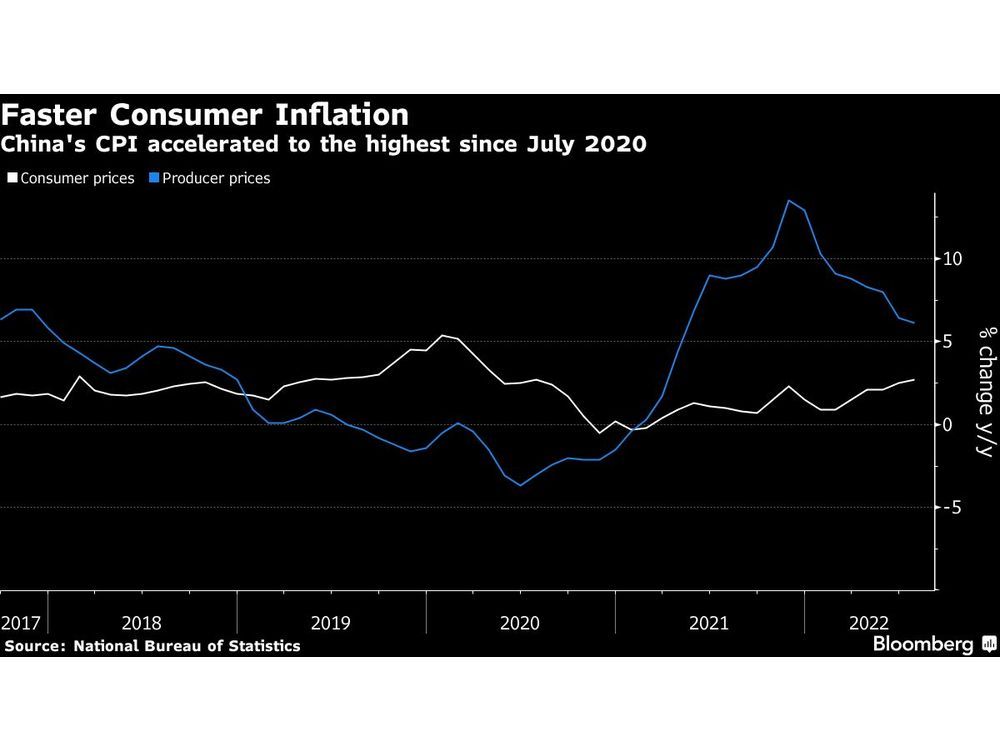Article content
(Bloomberg) — China’s consumer inflation accelerated in July to the highest level in two years, largely due to surging pork costs, while weak consumer demand kept overall price pressures in check.

[ad_1]
China’s consumer inflation accelerated in July to the highest level in two years, largely due to surging pork costs, while weak consumer demand kept overall price pressures in check.
Author of the article:
Bloomberg News
Bloomberg News
Publishing date:
Aug 09, 2022 • 10 minutes ago • 2 minute read • Join the conversation
![lm3hp8b7idyq0y]5v)cn[ebi_media_dl_1.png](https://wealthstreetinvestor.com/wp-content/uploads/2022/08/China-Consumer-Inflation-Reaches-2-Year-High-as-Pork-Surges.jpg)
(Bloomberg) — China’s consumer inflation accelerated in July to the highest level in two years, largely due to surging pork costs, while weak consumer demand kept overall price pressures in check.
This advertisement has not loaded yet, but your article continues below.
The consumer price index rose 2.7% last month from a year earlier as pork prices surged 20.2%, National Bureau of Statistics data showed Wednesday. The pickup in CPI was lower than the 2.9% median estimate in a Bloomberg survey of economists and compares with 2.5% growth in June.
Producer price inflation, meanwhile, slowed to 4.2% in July from 6.1% in June as commodity prices weakened.
In contrast to other major economies, consumer inflation in China has been relatively subdued this year as strict Covid control policies and sporadic outbreaks curbed consumer and business spending. Those virus flare-ups — along with global headwinds and an ongoing real estate crisis — have kept China’s economic recovery fragile, with factory activity unexpectedly contracting last month and property sales continuing to shrink.
This advertisement has not loaded yet, but your article continues below.
Rising pork prices and an improving economic picture, though, are expected to push up CPI this year, and may test the government’s ability to deliver more stimulus. At the same time, core CPI, which excludes the volatile prices of food and energy, remains weak at 0.8% in July, suggesting very little demand pressure in the economy to warrant concern from policy makers.
“Inflation will likely rise past 3% in the next two months, due to a low base and the lift from pork prices,” said Bruce Pang, head of research and chief economist at Jones Lang LaSalle Inc. “But core inflation will likely stay benign as domestic demand remains weak. This won’t cause much restriction to the monetary policy.”
China’s benchmark CSI 300 Index was down 0.3% in early trading on Wednesday, in line with the declines seen in broader Asian equities. The yield on the 10-year government bond yield fell 1 basis point to 2.73% while bond futures rose 0.2%.
This advertisement has not loaded yet, but your article continues below.
July’s inflation uptick was largely driven by gains in the price of pork, fresh vegetables and other foods, along with seasonal factors, the NBS said in an accompanying statement, citing senior statistician Dong Lijuan. Overall food prices rose 6.3% in July from a year ago, with pork prices, a key element in China’s CPI basket, posting the first year-on-year increase since September 2020.
Fresh fruits and vegetables surged 16.9% and 12.9%, respectively, from a year ago.
Analysts at China International Capital Corp said ahead of the CPI release that consumer inflation could breach the government’s target outlined earlier this year of about 3%. Even so, policy makers will likely tolerate higher inflation for the sake of stronger economic growth, the analysts said.
Chinese authorities have already signaled a willingness to let CPI creep somewhat higher.
“If we can keep the unemployment rate below 5.5% and the CPI rise stays under 3.5% for the whole year, we can live with a growth rate that is slightly higher or lower than the target, not too low of course,” Premier Li Keqiang said at an event with business leaders hosted by the World Economic Forum last month.
(Updates with additional details and stock moves.)
This advertisement has not loaded yet, but your article continues below.
Sign up to receive the daily top stories from the Financial Post, a division of Postmedia Network Inc.
A welcome email is on its way. If you don’t see it, please check your junk folder.
The next issue of Financial Post Top Stories will soon be in your inbox.
We encountered an issue signing you up. Please try again
[ad_2]
Image and article originally from financialpost.com. Read the original article here.